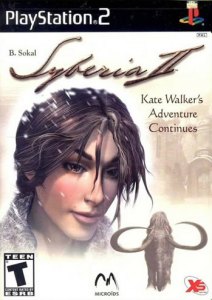Gamestyle Archive Intro: the joys of the point and click genre may be lost on the current generation. However it was a thrilling and challenging experience. Even after all these years I remember playing Syberia II just like it was November 2004 all over again.
Point ‘n’ click adventures have never really found a home amid the confines of current consoles; their pace, difficulty, static screens and quirks are everything that our newfangled entertainment centres would rail against. The Broken Sword series may have found a receptive audience, but far fewer releases have dared to stray from their PC stable (with the obvious exception being the behemoth Myst series). So, with this in mind, Gamestyle opens its mind to Syberia II.
The original Syberia managed to fill a niche on the Playstation 2, and although the sequel has hereto arrived on Xbox, it’s hardly likely to be usurping the top shelf. With virtually no marketing or any form of public awareness, Syberia faded away – and while the sequel is perfectly enjoyable in its right, the first half of the story owes a debt of continuity to the original. It goes without saying that point ‘n’ click adventures are nothing without internal dialogue, and Syberia II’s opening moments lack any reprise for those who are new to the series.
Thus, you again adopt the role of Kate Walker, a New York lawyer taking sabbatical in a remote permafrost region of Europe. She has left everything behind to join Hans Voralberg on his lifelong quest to find the legendary Syberia (note: this partnership is already formed and outlined in the first game). What does become clear is that Kate’s former employers are desperate to have her back in New York – and many co-opted locals will stop at nothing to prevent this enterprising duo en route.
The storyline was penned by Benoit Sokal, a notable European comic strip creator, and Syberia’s world is very much his oyster; the characteristic designs, technology, and architectural style are all very distinctive. If Gamestyle were to draw parallels, then Sokal’s nearest contemporary would be Jean-Pierre Jeunet – the director of City of Lost Children, Delicatessen, and (unfortunately) Alien Resurrection. Thankfully, the genre allows you to fully appreciate his clockwork apparatuses spread amongst four principal areas; these devices evidently inform the practices and history of the region and are truly mesmerising – and the snow (which is everywhere) adds an ethereal touch.
Syberia II offers no surprises in gameplay terms, and remains fundamentally true to its ‘point ‘n’ click’ roots: there are no quick-timed events or periodic bursts of activity required here. What awaits the player are a series of logistical tests (aka: puzzles) that must be overcome in order to progress. Initially the goal may seem simple – such as fixing a train – but the tasks sporadically branch out to incorporate a host of characters and town locations. Unfortunately, this does require a great deal of trial-and-error (and even more backtracking); the genre infamously takes no prisoners – so, if you are already cringing at the thought of it, then Syberia II is certainly not for you.
The difficulty curve is steep, and will prove extremely frustrating for the unwary (as there is no in-game help or hint system to speak of). The key is dragging your cursor across every inch of the screen – waiting for it to change appearance – then engaging in conversations and breaking down tasks by a simplistic ‘division of labour’ approach. Connoisseurs of such adventures will no doubt find Syberia II fairly straightforward to play – if it weren’t for several intrusive (or hereditary, given its PC lineage) factors.
Where should Gamestyle start – as a fair degree of testing should have highlighted the following problems: firstly, pathways are never clearly defined and are often hidden behind objects (or compounded by the white blanket of snow in certain areas). To discover that hidden route – typically off-screen – it is best to let Kate run in a circle; eventually she’ll spin off in another direction. Adding to this frustration are invisible walls that are in plentiful supply at nearly every location; a need for pinpoint accuracy (when opening objects or activating items) which is not served by console controllers; and each screen takes far too long to load – which, married to the quality of backtracking involved, only serves to infuriate players.
Notwithstanding, Syberia II is worth playing for its wonderful story and desire to overcome these obstacles. There’s a real sense of satisfaction when a cut-scene ensues, but even these moments can be short-changed by some dreadful editing (and sequences sometimes finish abruptly; the direction here is certainly amiss and the scripting could’ve been more polished). On a more positive note, there are some picturesque locations (and hand-drawn visuals) accompanying Syberia II, and the soundtrack is suitably evocative. Gamestyle certainly enjoyed its time in the snow, and would advise point ‘n’ click travellers to wait until the retail price falls a notch before taking a chance on this distinguished adventure.
Gamestyle Score: 6/10
